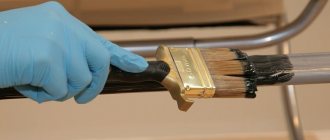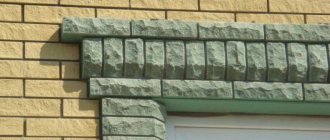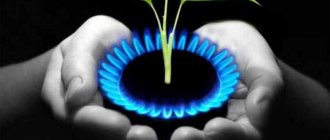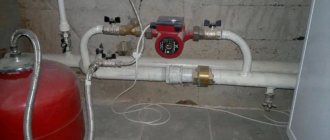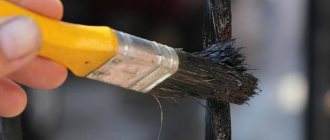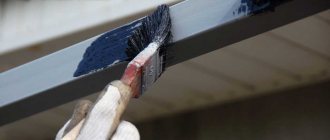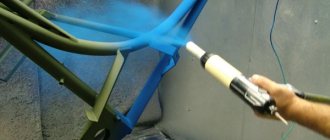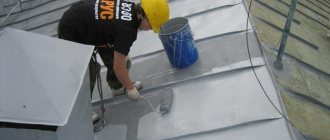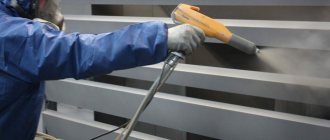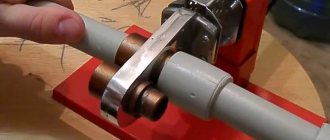The quality of the exterior decoration of a house is visually determined only by assessing the level of wall painting.
It doesn’t matter whether a complete layer-by-layer processing was carried out, the entire complex of work was done from scratch, or only cosmetic painting of the walls was done - outwardly everything looks exactly the same and for most it means the same thing - repairs have been made.
This is the main property of facade paint - the creation of a decorative outer layer that makes the appearance of the building new and elegant . Sometimes simply repainting the walls a different color looks like a complete change in the appearance of the house, affecting all elements of the architecture, although there were no structural additions or other interventions.
At the same time, painting the walls of a dacha touches on much more important operational issues, not limited to external effects. In this article we will talk about how to paint a private house with your own hands (+photo) and how to properly care for the surface.
Why do you need to paint the facade?
Painting the facade is the application of an external decorative and protective layer of the outer coating . In addition to purely visual changes, the paint layer creates a durable protective film that cuts off the wall material from the penetration of water from outside, from temperature influences, and eliminates the appearance of mold, mildew or algae.
In addition, an important ability of facade coatings is vapor permeability , i.e. the ability to remove moisture from the inside at the capillary level without the possibility of absorption from the outside.
Paints that do not have high vapor permeability are unsuitable for outdoor use, since steam, which does not have an outlet, begins to accumulate inside the walls, causing them to become wet, and ultimately the moisture freezes, expands and tears the walls from the inside.
Therefore, the correct choice of paint is a very important point; the durability of materials and structures, the possibility of proper operation of the wall pie, and only last but not least, the decorative qualities of the finish depend on it.
Sequence of work
So, first, an antiseptic primed composition is applied to the prepared surface, then the facade is painted. Primer is a reliable protection of wood from excess dampness, mold and mildew formation. The final layer is an oil or acrylate material.
| It is extremely important that the primer you use contains an antiseptic. It is recommended to apply it in several layers, waiting for each layer to dry completely. Paint is applied in the same way. As an experiment, it is better to paint a small piece of similar wood, so you can check the color and quality of the paint. |
The surface to be painted must be washed thoroughly, remove the layer of old paint, dust, resin, using a scraper or wire brush. Then it is recommended to degrease the surface using detergents containing alkali and begin painting after it has completely dried.
There are times when, in order to remove old paint, it is necessary to use a mechanical or chemical method of attacking the surface. Chemical cleaning is more labor-intensive, however, it preserves the structure and surface of the wood much better. It is used only in the most extreme cases.
Remember, the better the old paint is removed, the smoother and stronger the new layer will be.
Painting the facade walls should be done from top to bottom
Before painting, mix the paint well; you also need to periodically stir the material during the work. Do not start painting the walls of wooden buildings in case of rain, snow or sunny weather with direct sunlight on the working surface. Apply the paint using longitudinal movements.
When forming a glossy film on a wood surface, it is recommended to paint it in a darker tone. Walls with a first coat of oil-based paint can be coated with acrylate or similar paint.
Types of facade paints
Facade paints have approximately the same structural composition:
- Base (film former).
- Fillers.
- Pigments.
- Solvent.
Based on the type of paint base there are:
- Mineral. The basis is derivatives of cement and lime, which are inexpensive materials.
- Silicate. They are produced on the basis of liquid glass with additives. They have low water-repellent ability.
- Silicone. Expensive paints based on silicone resins. They have an excellent set of properties - high vapor permeability, completely impervious to water, very elastic. The reason for its rare use is the high cost of the material.
- Acrylic. One of the most common paint groups, it has good qualities and a relatively low price.
By type of solvent:
- Aquatic.
- Using organic solvents (white spirit, etc.).
IMPORTANT!
The choice of one or another type of paint is determined by the wall material and operating characteristics, climatic and weather conditions of the region.
The most popular manufacturers of acrylic, oil, water-based paint
Galamix. A Russian manufacturer that brings a significant amount of products to the market. They produce acrylic matte paint, textured facade paint for wood surfaces and textured paint for mineral facades. Acrylic paints are environmentally friendly, their service life is about 8 years. Textured paints do an excellent job of visually smoothing out any irregularities in the surface of the facade. The price from this manufacturer is about $1.2 per liter.
Dulux. Manufacturer of paints from England, producing water-based paints, acrylic, textured and matte quick-drying organic types of paints. Dulux paints are strong and durable. They guarantee protection of the facade from the occurrence and growth of fungus and mold. The service life is about fifteen years, and the cost is about $5 per liter.
Caparol. German paint production. We can say that this is the most popular type of paint. Famous for its impeccable quality. Suitable for painting any surface. Has an affordable price. Paints with thermal insulation properties are produced. Wide range of colors.
The well-known Caparol paint logo
Alpina. Famous for German quality and affordable price. It is used to paint plastered, brick, concrete and LShSU facades. It has excellent hiding power and lightfast shades. Reliably protects the facade.
Snowball. High-quality paint from a Russian manufacturer. It can be used to paint cement, lime, concrete, previously painted and plastered surfaces. It is characterized by high resistance and durability, resistant to natural phenomena. Wide palette of colors.
Beckers. A Swedish manufacturer that produces a whole series of facade paints. They are engaged in the production of matte water-based latex paints, acrylic paints, acrylate latex paints and alkyd-oil paints, to which linseed oil is added. They are well suited for painting concrete, metal and wood surfaces. Non-flowing and fits perfectly. They cost from $15 per liter.
Paint Backers
Ticurila. Swedish paint manufacturer. It produces acrylic-silicate, silicate, lime and base types of paints. They are good for covering lime, brick, concrete and cement surfaces. The company has also developed a whole series for painting wood surfaces. They have a wide palette of colors (about 190 types). The cost starts from $1.4 per liter.
PaintTicurila
Svyatosar. Russian manufacturer of facade paints. The products meet all current requirements for facade paints. They are engaged in the production of acrylic abrasion-resistant, restoration and frost-resistant paints. They also produce paints that can be used to paint metal surfaces.
Baumit. One of the leading Austrian brands, which has been on the market for more than 20 years. It produces a whole series of silicone paints for facades, which can be used to restore old houses, sanitize coatings, decorate new facades and paint thermal insulation systems. They cost from 1.2 dollars per liter.
Recent Entries
Soldering or crimping electrical wires Why is there humidity in the apartment and what to do Chopped at home: technical features and advantages
Water based paints
Water-based (water-dispersed) paints are an emulsion of small particles of a working mixture in water . When applied, water is partially absorbed into the base, and partially evaporates, leaving a coating film that, after drying, does not react at all to the influence of water.
This composition has important advantages:
- No smell . This is the main advantage of water-based materials, which often determines the choice of users.
- No strong shine . The surface has either a deeply matte or soft silky sheen. Visually matte surfaces look smoother, do not glare and create a noble and stylish appearance of a house or cottage.
- Availability of excellent working qualities of the coating . Almost all water-dispersed paints have a full set of properties that allow them to successfully perform their functions.
- Possibility of tinting in any color . All water-based compositions are available in the form of two or three types - bases. Usually the first one is white and can be used as an independent paint or tinted in some light shade. The second and third are transparent, intended for tinting into denser and brighter colors.
- Low consumption . Most water-based formulations have high hiding power and low (relatively) density, which allows them to cover a larger area than other types of paints.
- Quick drying . Unlike other types, water mixtures dry within a few hours, allowing for maximum speed of work.
- Plain water is used as a diluent, which makes the work much easier (and cheaper) and helps keep the working tools in order and clean.
The disadvantages of water-based paints are:
- Contraindications for use on metal substrates.
- Weather restrictions, cannot be applied in rainy weather.
- The stains that appear are difficult to erase, and repeated washing of the walls spoils the appearance of the coating.
The disadvantages of water-dispersed facade paints are not critical; the popularity of such compositions is steadily growing.
DIY facade painting
Preparing the base for painting
Before starting painting work, you need to prepare the facade for painting in a certain way.
For this:
- We check the mechanical strength of the base by running a metal spatula over it. If fragments peel off or crumble from the facade, a separate finishing of the facade for painting is required. We clean the crumbling parts, treat them with a hydrophobic solution and putty.
Facade primer - Next, we cover the facade with a primer . This is done in order to ensure high-quality adhesion of the paint to the base. Instructions from the manufacturer of a specific brand of primer will help you determine the optimal application technique.
Advice! It is not recommended to use drying oil instead of an acrylic-based primer! This can lead to disruption of the adhesion of the paint layer to the drying oil, and as a result, to rapid cracking of the paint.
- If we paint a highly absorbent surface (limestone, brick, fresh cement), we cannot do without an additional primer . This is due to the fact that such surfaces intensively draw water from the paint, preventing high-quality film formation.
Painting the facade
Wagner painting machine
The façade painting work itself is not particularly difficult. If you are faced with the task of painting a large-area facade, you can use special equipment for painting facades (Wagner and Super Finish painting machines have proven themselves well).
But for not very large-scale work. for example, to paint a wooden facade, a paint roller and a rack will be enough to reach high places.
Painting a high-rise facade
Advice! For multi-storey buildings, often the only finishing method is to paint the facades with climbers. This is due to the need to obtain permission to work at heights - and therefore we strongly do not recommend trying to paint facades at height yourself!
The technique for painting the facade is shown in the video attached to this article - so we will limit ourselves to only brief instructions:
- We pour the paint into a special trough to make it convenient to apply it to the roller.
- After removing excess paint from the roller, roll it over the selected area in one direction. We make each subsequent roll of the roller, overlapping the previous strip by 3-4 cm.
- We start painting the facade of the building from the corners - these are the ones that need to be painted especially carefully.
- We paint the base of the building last - after all, excess paint will flow down.
- One hour after applying the first coat, the finishing coat can be applied. It is applied with undiluted paint and allowed to dry, protecting the façade from exposure to precipitation.
- Protrusions, columns, window sills, and other architectural elements can be painted in a different color - this will “revive” the design of the building (see photo).
Facade with contrasting elements
As you can see, painting the facade of a building itself is not particularly difficult, and can be done even by a non-professional, unlike the installation of other finishing materials for facades. But in order to choose the right paint and prepare the base for its application, you need to study a fairly large amount of information. But the final result is definitely worth the effort!
Organic based paints
Organic-based materials are more traditional because they have been used for a long time. Many users prefer them precisely for this reason, not trusting the apparent fragility of water-based compositions.
Organic-based paints have many advantages:
- Durability of the coating.
- Elasticity, the ability to compensate for minor movements during shrinkage.
- Water resistance.
- Frost resistance.
- Vapor permeability.
- Compatible with most surfaces , excellent adhesion to metals.
- Tolerance of sudden temperature fluctuations.
- Durability.
- Possibility of painting at low temperatures or high humidity.
The disadvantages include:
- Pungent odor upon application and for some time after drying.
- Drying one layer requires a long time - two days; for subsequent layers, the drying time increases.
- The need to use solvents, which increases costs.
Organic solvent paints have a strong shine. This property causes different attitudes - for some it is very desirable, others consider it a disadvantage.
NOTE!
In addition, a significant disadvantage of organic solvent paints is the strong odor , which is very poorly tolerated and can cause poor health in some people.
This circumstance reduces the competitiveness of such paints compared to water-based paints, although the other qualities of the material are quite successful and make it possible to create a durable and durable coating.
Tools and mechanisms for applying paint
Not only the uniformity of application of the coloring composition, but also the speed of painting the facade depends on the correct selection of tools. The best option is to combine several devices.
Brush
You will need a brush anyway. If you paint with a spray gun or roller, then hard-to-reach places will still have to be treated with a brush. This device may differ in the length of the pile, its width, as well as the material of manufacture. With a brush you can:
- achieve perfect surface painting;
- paint walls with defects and carefully hide them;
- implement original design ideas.
Even though the brushes are very light, there is a nuance to their use. Painting the facade with their help will be quite time-consuming and labor-intensive.
Roller
For painting facades, special facade rollers are offered on the market. They may contain natural or synthetic fibers. The light weight of the device, the ability to adjust the length of the handle, and a relatively large surface grip make this tool very popular. The cost of rollers is reasonable, so they are in great demand. With their help you can:
- speed up the painting process;
- create large patterns, for example using a stencil;
- treat textured surfaces.
An important nuance when painting is the paint consumption, so you need to carefully dip the roller to avoid overspray.
Spray gun
A spray gun is ideal for treating large areas. These modern devices can be electric or pneumatic. With them it is easy to achieve uniform and high-quality painting on walls of any size. Their operation and maintenance are quite simple. The only disadvantage of such paint sprayers is their high cost.
How to choose façade paint for a specific surface?
- First of all, to correctly select the outer covering, you should take into account the base material . Most façade coatings specialize in concrete (including after wall insulation with foam plastic), brick, aerated concrete and plasters of various compositions. At the same time, water-based paints are not always suitable for wooden surfaces and are completely unsuitable for application to metal (steel) substrates, which is the main difference from paints based on organic solvents, which serve as reliable protection for such substrates.
- The second selection factor is surface quality . The presence of shine and the color of the walls directly depend on the composition of the paint used for exterior decoration. Water-based mixtures have lighter tones and a predominantly matte surface, while organic-based materials make it possible to obtain coatings with a hard shine in dense tones, and the choice of color and its tonality is much wider than that of water-based paints.
- At the same time, we must not forget about the operating conditions of the building - in areas with high levels of atmospheric pollution from various industrial or other substances, dust or the presence of large amounts of exhaust gases (industrial or close to large highways), paints with high water-repellent ability should be used , allowing you to safely endure periodic cleaning the walls. For regions with frequent rains, this choice is also relevant, since the penetration of rainwater into the wall material threatens their destruction.
The process of painting the external walls of a wooden building
At their core, the methods used to paint the front side of wooden houses are not much different from the methods of covering buildings sheathed with other materials. But small differences can still be noted.
Wooden walls are most often coated with certain types of paints: transparent and opaque, acrylate and oil paints.
Antiseptic-based paints are used to protect wood. Such compositions are capable of penetrating into wood to a depth of several millimeters. Antiseptic transparent paints are widely used, which can highlight the structure of the wood itself. This option is very convenient when the wood has an attractive shade and good surface treatment.
Antiseptic-based paints can be available in a variety of colors and shades
The translucency of this material somewhat overlaps the main color, however, like transparent material, it highlights the structure of the wooden facade.
Which façade paint is most optimal?
The optimally selected material must best comply with all existing conditions - operational, climatic. In addition, the decorative qualities of the coating are important, since they are primarily assessed when looking at a freshly painted house.
Recently, user preferences are increasingly given to water-dispersed compositions , which is understandable by their properties. The most important of these is the absence of odor.
The ability to remove paint stains with plain water is also important - an important plus, since solvents can also remove the necessary substances, which will lead to damage to objects accidentally stained with paint.
Preparing the wall surface for painting
For painting you will need a clean, dry wall surface.
To prepare you will need:
- Disconnect all hanging structures - brackets, awnings, lights, air conditioners, etc.
- Remove trim from windows or doorways.
- Inspect the walls, determine the degree of wear of plaster or other materials.
- Detected defects are puttied; in case of large quantities of peeling or shedding, it is recommended to apply a leveling plaster layer.
- Some types of facade paints require preliminary priming.
CAREFULLY!
Freshly applied cement or lime plaster must be allowed to sit for 4 weeks (minimum) before painting to complete crystallization of the layer and complete chemical processes within the plaster.
Choosing paint for exterior work depending on the type of walls
In order for the decorative layer to serve as long as possible without the need for restoration, when choosing a paint composition, it is important to take into account the specifics of the base. Wood, foam blocks, brick and concrete have different requirements for the finishing coating
For wood
It is quite difficult to find good facade paint for wood, since plank walls are capable of rapid fire, quickly absorb liquids and are susceptible to rotting. In such conditions, the optimal solution will be substances that are not afraid of constant exposure to moisture, exhibit high-quality adhesion and excellent ductility.
When choosing paint for a wooden facade, first of all, they turn to acrylic products, since they are characterized by full adhesion to wood, help maintain natural air exchange, are quickly applied and have an impressive service life.
For a wooden house, transparent and tinted compounds are used; in the first case, the beautiful structure of the natural material is emphasized; such products have greater vapor permeability.
For foam block
Foam block surfaces are characterized by high porosity; they require full protection from moisture and contamination. The paint must exhibit serious water-repellent and vapor-permeable properties, so experts here recommend rubber and silicone compounds
When painting, special attention must be paid to the integrity of the seams so as not to form cold bridges and not cause rapid destruction or peeling of the finish.
For brick
Brick, accumulating salts, periodically releases them in the form of stains; this effect is especially noticeable after the rainy season. On such a surface, peeling and mossy areas quickly form. Therefore, builders prefer to paint brick walls only after several years of operation of the building.
The following requirements apply to coloring compositions:
- neutrality in contact with chemicals;
- mechanical strength;
- ability to release steam;
- resistance to atmospheric agents.
To decorate brick facades, substances that exhibit excellent elasticity are used: temperature fluctuations can cause expansion or contraction of the base, under such conditions the finishing is at risk of deformation and cracking.
An example of applying façade paint for brick
For ordinary solid bricks, acrylic paints can be an excellent compromise - they do not interfere with air exchange, eliminate the formation of efflorescence, and are not afraid of moisture. Walls made of silicate material need to be finished only with cement or silicate products. Ceramic brick is not demanding; it can be combined with any type of coating.
Water-based rulers can also be used for finishing bricks, but they are not appropriate in all cases, since high susceptibility to moisture is a disadvantage in conditions of frequent precipitation.
For concrete
Concrete is painted not only to improve its decorative properties, it is important to strengthen its operational capabilities and protect it from climatic conditions. Despite its initial strength, concrete quickly deteriorates in conditions of high humidity.
Concrete compositions must meet the following requirements:
- moisture repellency;
- long color retention;
- frost resistance;
- environmental friendliness;
- ease of application.
This base is compatible with almost any composition, but it should be borne in mind that each type of paint and varnish material has disadvantages when used in this way. For example:
- oil paints do not exhibit sufficient vapor permeability; they require preliminary preparation of the walls;
- water-based solutions do a poor job of preventing moisture absorption.
Silicone, acrylic, and rubber series are more appropriate here.
Facade painting technology
Painting work is carried out in dry, windless weather.
The air temperature should be:
- For water-based paints - from +5° to +30°.
- For compositions based on organic solvents, the temperature range expands to the lower side (there are brands of paints that allow use down to -20°), but due to the strong odor, use in hot weather is difficult.
Paint is applied either mechanically - spray gun, air or airless spray, or manually using a roller or brushes.
IMPORTANT!
Before applying paint, be sure to carefully read the application method and additional working conditions in order to avoid possible mistakes.
Depending on the type of paint, the surface must be covered entirely at one time (mainly, such conditions apply to water-based coatings, since the junctions of different layers are very noticeable), or interruptions in work are possible (paints based on organic solvents).
Most often, the surface is painted in two layers, the interval between applying the second layer of paint is usually 16-24 hours.
What color to paint the facade of the house
To achieve harmony of all elements of the facade, when painting you need to consider:
- the color of the walls and roof should be different;
- if there are protruding elements, then it is better to highlight them with a different shade;
- it is necessary to observe the rule of contrast, if not parts of the house, then at least the landscape and facade;
- To obtain an ideal result, it is recommended to use three shades when painting.
As for the color itself, there are no restrictions. It all depends on the desires and preferences of the owner.
Features of painting in two colors
When painting a facade in several colors, it is worth starting with small details. They are painted first with a brush, and then only move on to the main surface. In this case, it will be possible to disguise the paint that got on the walls when painting small parts.
Painting walls in two colors
Tips for caring for painted surfaces
Maintenance of façade coverings is minimal. No action is required other than occasional hosing to remove dust.
The application of any protective compounds or other actions aimed at improving the condition of the coating is not used, since the quality and properties of the coating fully meet all requirements and do not require additional measures.
Facade paints, with all the breadth of assortment and variety of types, perform the same task. Since they are created precisely for this purpose, the difference in properties is not critical and consists only of some positions.
Water-based paints and materials based on organic solvents are able to fully satisfy all requests and provide high-quality protection of walls from external destructive factors, as well as decorate the house and create a stylish and neat appearance.
The nuances of painting the facade
Work should begin with painting areas that catch the eye during the initial examination. Be sure to protect window and door frames, as well as adjacent, previously painted areas.
Where paint does not reach during mechanical painting, and where it is difficult to paint with a roller, the wall is painted with a brush. To prevent dust from sticking to the long-drying paint, a film screen is made in front of the wall of the house.
Having chosen what to paint the facade of the house with plaster today, leave a note for yourself somewhere about what paint you used to paint the facade. Observe how the paint behaves during use. Inspect the property after 3-4 years. If the house looks like it was just painted, the paint was chosen correctly, the type is yours! Don't look for anything better for subsequent façade painting on plaster.

